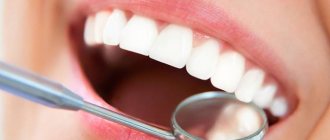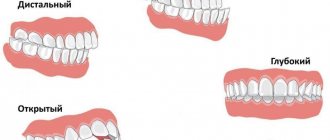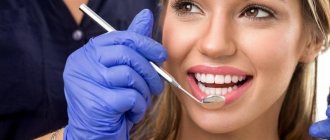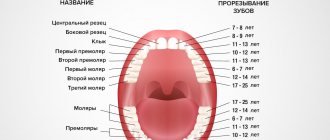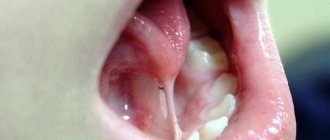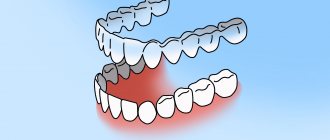Most often, many parents postpone visiting the orthodontist with their child until he is 7-9 years old. However, this is not entirely the right solution, because if there are problems associated with malocclusion, it is easier to solve them before the age of 5. If time has passed, what needs to be done and how to begin correcting malocclusions? At what age can you get braces and until what age do you have braces?
When to put braces on a child
Parents who carefully monitor their children will, of course, immediately notice that their child’s bite is developing incorrectly. Treatment will also be indicated for those babies who:
- parents had a history of malocclusion;
- nasal breathing is impaired as a result of a cold or adenoid disease;
- there are problems with the spine and poor posture;
- bad habits are observed, namely: thumb sucking, other objects and pacifiers for more than 6 hours a day;
- there is a predisposition to diabetes mellitus and diseases of the central nervous system.
Doctors have different opinions regarding bite correction in children. Some believe that it is most successful if it is done at an early age, while others are convinced that older children should have their teeth straightened.
Possible complications
Failure to maintain good oral hygiene and a number of other factors can cause various complications when wearing braces.
When a child wears this design, the following may occur:
- severe pain in teeth or gums;
- allergic reaction to the construction material;
- caries;
- diction disorders;
- weakening of tooth enamel.
When the braces are removed, a lot of space in the dentition is freed up. This can cause additional teeth to appear and become displaced.
At what age are braces placed?
Depending on the age category, the correction of malocclusion is carried out using different methods. For the treatment of children, removable devices are used that actively influence the restructuring of muscles and form the correct development of bones. At this age, the child’s jaws are actively developing, which means they are easily amenable to such correction.
At what age is it recommended to take steps to start treatment? Some experts recommend starting at the age of five, while others argue that the most suitable period is from 7 to 9 years.
Attention! At this age, the use of braces can cause damage to the enamel, so this type of treatment should only be carried out based on compelling medical indications.
In this case, it is customary to take into account the main criteria that determine the readiness of the child’s body to carry out corrective measures:
- the baby has upper permanent incisors;
- The length of the baby’s teeth allows the system to be attached to them.
Orthodontic correction of malocclusion in young children has a positive effect on the development and growth of the jaws, creates conditions for the formation of correct bite, and facilitates correction of the bite in the future.
To correct malocclusion in children aged 11-13 years, fixed structures are used. This time is favorable for the active growth and development of the jaw bones. To select the most favorable time to begin correction, the doctor pays attention to the following criteria:
- general physical development of the child;
- condition of tooth enamel;
- type of bite
Why do parents need to carefully monitor their children's teeth?
Orthodontics is a fairly new science in the CIS countries, but its development and improvement of techniques is gaining momentum every year. Different orthodontists have different opinions regarding at what age children should be given braces. At the same time, more experts believe that bite correction should be done when the child’s baby teeth are replaced by permanent ones, in other words, during the active growth of the jaw bones.
Note: Braces can be used at the age of 50, but you need to understand that the time, starting with the replacement of baby teeth with permanent ones and ending with puberty, is most optimal and gives the best results.
When is the best time to get braces?
If a child has already been diagnosed with an incorrect bite, then the first steps to correct it can be taken immediately. Up to 13 years of age, treatment is carried out using removable plates, since at an early age the bite is not yet fully formed. The jaws reach their permanent position at approximately 14 years of age – it is during this period that it is advisable to get braces for a child. Treatment using them will be the most effective.
In adolescents, molars are already fully formed, so they can already withstand a load that is not entirely natural for them. At this time, the question is no longer raised when it is possible to put braces on a child. But when installing braces before 12-13 years of age, there is a high risk of resorption of incompletely formed roots. After such a procedure, a small patient may lose teeth, so at any age, before carrying out correction using braces, a full diagnostic examination of the condition is carried out.
Construction device
Braces have been around for a long time. With constant improvement, their design has remained virtually unchanged today.
Elements that make up the bracket system:
- The bracket itself (translated from English means “bracket”). These are clasps that are attached to each tooth and are not removed until the end of treatment. 10 such brackets are used for each jaw. Most often, treatment is carried out simultaneously on the upper and lower jaws.
- Arc made of nickel and titanium. It is dented to its original shape, so it is the main element of the system responsible for correcting teeth. The diameter and density of this element may vary. Sometimes the arch is made individually.
- A ligature consisting of a wire and a rubber ring. It is used to fasten the individual parts of the arc.
- In some cases, additional rings, springs and chains are also used.
Installing braces for children
Before starting orthodontic correction of malocclusion in a child, parents need to consider some features:
- It is not recommended to install braces until the second molars have erupted. It is necessary to wait so that each tooth takes its place, since there is a risk of them erupting in another place, outside the dentition. Consequently, the treatment period and the likelihood of relapse will increase.
- Before installing braces, it is necessary to check the condition of the oral and internal muscles. This procedure is carried out in order to exclude dental anomalies and disproportionate development of bone and muscle tissue.
- It is necessary to clarify how the load on the teeth occurs, which is important in preventing relapses. If some teeth close before others, the risk of recurrence of crookedness increases significantly. This information is essential in constructing a consistent correction plan and determining the exact timing of treatment.
Mechanism of action
Correction by this method is based on the ability of teeth to shift under mechanical influence from the outside. They are fixed in the jaw in a movable manner. Systems allow units to be corrected to be offset. This happens by pulling them out of the alveolar process, or vice versa, by deep immersion into the socket. It allows you to rotate them around their axis or tilt them in the required direction. With prolonged exposure, the bone of the alveolar process is resorbed, freeing up space for displacement. On the opposite side, where the dental ligament is stretched, bone tissue grows and the tooth is fixed in the required position.
How to install braces
Braces are fixed on the outer and inner surfaces of the teeth using a special material. Modern braces systems are divided into metal, ceramic, and lingual. The cheapest of them are metal ones, the most expensive are lingual ones, since they are attached to the inner tooth platform and are practically invisible. Ceramic devices have no equal in popularity.
Before installing braces, they undergo an examination, followed by preparation of the oral cavity. At this stage, impressions are made from plaster, and a complete sanitation of the oral cavity is carried out. The process of correcting the bite begins at the moment when a special arch is installed in the grooves of the braces, putting pressure on the teeth and causing them to shift.
Installing braces is painless, but discomfort may occur later. Getting used to braces takes about 3-5 days. Depending on the severity of the disease, the braces system is worn from one to three years under constant medical supervision. To consolidate the result, the patient will need to use retainers—special removable plates—for some time.
Rules of care
The design features of braces systems increase the likelihood of developing inflammatory and carious processes in the oral cavity, so you need to take special care of your teeth during the treatment period.
Be sure to follow the following recommendations:
- brush your teeth after every main meal;
- in the morning and evening you need to use special (V-shaped, mono-beam) toothbrushes and brushes;
- use an irrigator and rinse aids.
Parental supervision, especially in the case of younger children, increases the effectiveness of care.
It is also necessary to monitor the child’s diet: you should not eat solid foods (nuts, crackers, seeds), or sticky foods. It is not recommended to drink drinks with food colorings, and you should avoid sports that pose a risk of injury.
You need to brush your teeth with braces not only with a regular brush, but also with a special brush.
Until what age do you have to put braces on your teeth?
Despite the fact that the use of braces presents some difficulties for teenagers, it is at this age that bite correction is most effective. Any changes take place within a year and a half, while for a mature person this is only a minimum period of time. It will take about 2-3 years to establish the bite of an adult, and the retention period will be at least 5 years. A large number of doctors are convinced that to prevent relapse in adulthood, it is necessary to install permanent retainers or use mouth guards every night.
Sources used:
- Canadian Association of Orthodontists
- Proffitt U.R., Modern orthodontics (3rd edition), MEDpress-inform, 2015, 560 p.
- Anikienko, A.A. Hardware orthodontic treatment and its subordination to the physiological laws of irritation / A.A. Anikienko, N.V. Pankratova, L.S. Persin. — M.: Medical Information Agency
- Nanda, R. Biomechanics and aesthetics in clinical orthodontics / R. Nanda. — M.: MEDpress-inform
Optimal age category
According to orthodontists of the “Smile” dental clinic network, the optimal period for correcting occlusion using braces is from 13 to 18 years. Treatment after adulthood is also effective, but takes longer.
The effectiveness of therapy depends not only on the patient’s age, but also on other associated factors:
- the complexity of a particular clinical case;
- physiological characteristics;
- correctly selected correction system;
- a person’s discipline associated with maintaining oral hygiene and timely visits to the clinic to adjust the orthodontic device.

